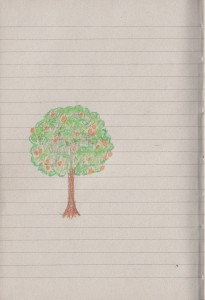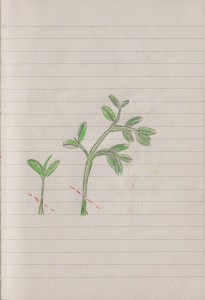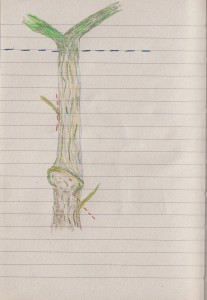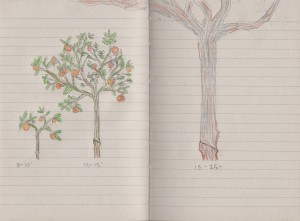A Thing Or Two About Fruit Trees
 For anyone interested in growing fruit tree(s) and anyone interested in how their fruit is grown.
For anyone interested in growing fruit tree(s) and anyone interested in how their fruit is grown.
With exception to tropical fruit, most of the commercially available fruit (citrus, apple, peach, avocado, etc) does not exist in the wild. The fruit we consume was created from selective breeding (hybridization) and accidental discovery. These fruit are mutant fruit; if you will.
“Hybridization occurs in one of three ways. People can manually cross citrus through assisted sexual reproduction, transferring pollen from one plant to another and seeding from resulting fruit. This kind of trial-and-error, wait-and-see experimentation requires great patience. Alternatively, people can hunt for desirable varieties that appear spontaneously on eccentric tree branches– mutations known as bud sports or chimeras. In the atomic age, plant breeders gained a third technique: bombarding seeds with radiation to induce mutations. (The popular Rio Red grapefruit came into being at Brookhaven National Laboratory on Long Island.) Once a desirable varietal has been created or discovered, it must be asexually copied to be perpetuated. Citrus hybrids are unstable: sweet orange seed may sprout into a sour lemon. Only grafting produces uniform, predictable results.”
Farmer, Jared. Trees in Paradise: A California History. New York: W. W. Norton, 2013. 227-228. Print.

As such, growing a mutant fruit tree from seed is often futile. The seed contains random characteristics of the original tree and the resulting fruit often does not have the desired characteristics.
Instead, new trees are grown by taking a cutting from a tree with desirable fruit traits and grafting the cutting onto a rootstock.When grown from seed, a tree can take upward to 15 years to bear fruit. Grafting speeds up the process immensely.
Rootstocks are trees grown from seed. They are selected for certain characteristics like how fast they grow or for disease resistance.
After a couple to few years, the truck of the seed grown tree will be wide enough to be used as rootstock. The tree will be cut off at the base at a 45 degree angle and a cutting will be grafted onto it. Once on the rootstock, the cutting is then refereed to as the “scion.”

When looking at a franken-fruit tree, it is easy to spot where the graft is. Often times the graft area is a little bulged out. Further, the rootstock and scion have different texture and coloration.
From time to time, the tree will send out shoots (or suckers). Generally, it is best to cut them off. A good bet is everything below where the tree branches out.
It is IMPORTANT to cut off any suckers that grow from the rootstock. If the sucker is allow to grow, the scion will be rejected and the rootstock will become the tree.
 More on rootstock: one of the characteristics of rootstock is the rate of growth and overall size that the tree will grow.
More on rootstock: one of the characteristics of rootstock is the rate of growth and overall size that the tree will grow.
There are three types: dwarf, semi-dwarf, and standard. Dwarf trees will grow to about 8-10 feet tall and as wide. Semi-dwarf, 12-15 feet. Standard 18-25 feet.
Dwarf vs Semi Dwarf
The selection between the two will be dependent on how much space you have and how much fruit you will like to get.
Dwarf: At $25 a pop, the ROI (return on investment) takes several years. If you are not about that, dwarf trees are good if you’re looking for a tree that will have fruit on the tree to use at your convenience. It is nice having access to a lemon within walking distance when a sudden urge for lemonade shows up. Since these trees are small, there is not an over abundance of fruit.
Semi-dwarf: For some types of fruit, it only makes sense to get a semi-dwarf. Mandarians are a good example. I can polish off a 5 foot tree’s worth myself. Choose this rootstock for fruit that you need a lot of.













![#gardentotable #dưamón (Vietnamese dried then refrigerator pickled daikon radish) with my aunt's homemade #banhtet (sweet rice roll with mung bean and fatty pork seasoned with salt & Sichuan pepper*; tightly wrapped with banana leaves and boiled.)
*Teochew variation
Banh Tet is 'Cake of the Spring Festival.' It is made and given as gifts in South Vietnam and where this culture resides. [Photo 4: banh Tet dressed with festival paper.]
It is therefore a common food of the #springfestival. [Photo 3: banh Tet before it is crisped up with some oil on a pan.]
While it is often crisped up and consumed, an accompanying pickle can be used to add another element to this simple comfort food. From our garden we used a volunteer daikon radish and a couple of 'Bolero' carrots. I made this from memory of my dad making it. I cut the daikon into steak fries shape and dehydrated them. For the brine my mom advised. It consists of fish sauce, sugar, and water. The concentrates are dependent on taste and the strength and salinity of the fish sauce.
My dad preferred it on the saltier side; whereas traditional Vietnamese flavor profiles prefer salty and sweet.
[Photo 2: All said and done, reusing a food jar is key to maximum wholesomeness 😉😝😅]
Note: There appears to be two variations of dua mon-- traditional Vietnamese and Teochew. By dehydrating instead of sweating (partially removing water,) the daikon is crunchy and elastic; making it a very classic #teochew texture profile.
See more Spring Festival/Chinese Lunar New Year/#Tet posts at: #ned_springfestival](https://scontent-bos5-1.cdninstagram.com/v/t51.29350-15/427935298_939543330529922_6652804083994273886_n.heic?stp=dst-jpg_tt6&_nc_cat=105&ccb=1-7&_nc_sid=18de74&_nc_ohc=vkEDByqoZx0Q7kNvgHmpPVO&_nc_zt=23&_nc_ht=scontent-bos5-1.cdninstagram.com&edm=ANo9K5cEAAAA&_nc_gid=AQ0O70jJaui1vEB9PUvt3AX&oh=00_AYBk3qRj1cCMa6BqfnEwNod7NHlW62OWfOkbJHhY2vTRcw&oe=675657AE)


 . The ghostly photo was create
. The ghostly photo was create


